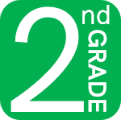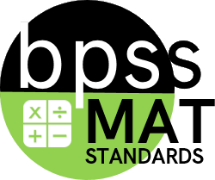BPS District Mathematics Standards Book
K-8 Grade Levels
Grade 02
Second Grade Math
"I can ... statements"
 In 2nd grade, your child will build on last year’s work and gain important new skills. One of the most important outcomes for the year is to add and subtract two-digit numbers quickly and accurately (e.g., 77 – 28). Another important goal in 2nd
grade is to understand what the digits mean in a three-digit number such as 463 (namely, 463 is four hundreds, six tens, and three ones). Your child also will build expertise with solving addition and subtraction word problems. Mastering addition
and subtraction at the 2nd grade level is important so that your child will not have to review and repeat this material in 3rd grade, when the study of multiplication, division, and fractions will start.
In 2nd grade, your child will build on last year’s work and gain important new skills. One of the most important outcomes for the year is to add and subtract two-digit numbers quickly and accurately (e.g., 77 – 28). Another important goal in 2nd
grade is to understand what the digits mean in a three-digit number such as 463 (namely, 463 is four hundreds, six tens, and three ones). Your child also will build expertise with solving addition and subtraction word problems. Mastering addition
and subtraction at the 2nd grade level is important so that your child will not have to review and repeat this material in 3rd grade, when the study of multiplication, division, and fractions will start.
MAT-02.OA Domain:
[OA] Operations and Algebraic Thinking
- MAT-02.OA.01 Use strategies to add and subtract within 100 to solve one- and two-step word problems involving situations of adding to, taking from, putting together, taking apart, and comparing, with unknowns in all positions
- MAT-02.OA.02 Use mental strategies to fluently add and subtract within 20.
- MAT-02.OA.02.a Fluently add basic facts within 20 using mental strategies* MAT-02.OA.02.b Fluently subtract basic facts within 20 using mental strategies*
- MAT-02.OA.03 Determine whether a given number of objects up to 20 is odd or even. Write an equation to represent an even number using two equal addends or groups of 2.
- MAT-02.OA.04 Use addition to find the total number of objects arranged in rectangular arrays with up to 5 rows and up to 5 columns. Write an equation to express the total as a sum of equal addends.
MAT-02.NBT Domain:
[NBT] Number and Operations in Base Ten
- MAT-02.NBT.01 - Demonstrate understanding that the three digits of a three-digit number represent amounts of hundreds, tens, and ones, including:
- MAT-02.NBT.01.a 100 can be thought of as a bundle of ten tens called a hundred.
- MAT-02.NBT.01.b Multiples of 100 represent a number of hundreds, 0 tens, and 0 ones.
- MAT-02.NBT.02 Count forward and backward from any given number within 1000. Skip-count by 5s, 10s, and 100s.
- MAT-02.NBT.03 Read and write numbers to 1000 using base-ten numerals, number names, and expanded form.
- MAT-02.NBT.04 Compare two three-digit numbers based on meanings of the hundreds, tens, and ones digits, recording the results of comparisons with the symbols >,=, <
- MAT-02.NBT.05 - Use strategies based on place value, properties of operations, and/or the relationship between addition and subtraction to fluently add and subtract within 100.
- MAT-02.NBT.06 Use strategies based on place value and properties of operations to add up to four two-digit numbers
- MAT-02.NBT.07 Demonstrate understanding of place value within 1000 when adding and subtracting three-digit numbers. Use concrete models or drawings and strategies based on place value, properties of operation, and/or the relationship between addition and subtraction to add and subtract within 1000. Use a written method to explain the strategy.
- MAT-02.NBT.08 - Mentally add or subtract 10 or 100 to or from a given number between 100 and 900
MAT-02.MD Domain:
- MAT-02.MD.01 Select and use appropriate tools to measure the length of an object
- MAT-02.MD.02 Measure the length of an object using two different standard units of measurement. Describe how the two measurements relate to the size of the units chosen.
- MAT-02.MD.03 Estimate lengths using units of inches, feet, centimeters, and meters
- MAT-02.MD.04 Measure to determine how much longer one object is than another, expressing the difference with a standard unit of measurement
- MAT-02.MD.06 Represent whole numbers on a number line diagram with equally spaced points. Represent whole-number sums and differences within 100 on a number line diagram.
- MAT-02.MD.07 Tell and Write time to the nearest five minutes with a.m. and p.m. using analog and digital clocks
- MAT-02.MD.08 solve word problems involving dollar bills, quarters, dimes, nickels, and pennies, using dollar and cent symbols appropriately
- MAT-02.MD.09 Generate data by measuring lengths of objects to the nearest whole standard unit. Show the measurements by making a line plot, using a horizontal scale marked off in whole-number units
- MAT-02.MD.10 Draw picture graphs and bar graphs with single-unit scales to represent data sets with up to four categories. Solve simple put-together, take-apart, and compare problems using information presented in a bar graph.
MAT-02.G Domain:
- MAT-02.G.01 Identify trapezoids, rhombuses, pentagons, hexagons, octagons, parallelograms, quadrilaterals, cubes, spheres, cylinders, cones, triangular prisms, rectangular prisms. Recognize and draw shapes having specified attributes, such as a given number of angles or a given number of equal faces.
- MAT-02.G.02 Partition a rectangle into rows and columns of same-size squares and count to find the total number
- MAT-02.G.03 Partition circles and rectangles into two, three, or four equal shares. Describe the shares using the words halves, thirds, half of, a third of, etc., and Describe the whole as two halves, three thirds, four fourths. Recognize that identical wholes can be equally divided in different ways. Demonstrate understanding that partitioning shapes into more equal shares creates smaller shares.
A Sample of What Your Child Will Be Working on in Grade 02
- Solving challenging addition and subtraction word problems with one or two steps (e.g., a “one-step” problem would be: “Lucy has 3 fewer apples than Julie. Julie has 47 apples. How many apples does Lucy have?”)
- Quickly and accurately adding with a sum of 20 or less (e.g., 11 + 8); quickly and accurately subtracting from a number 20 or less (e.g., 16 – 9); and knowing all sums of one-digit numbers from memory by the end of the year
- Understanding what the digits mean in three-digit numbers (place value)
- Using understanding of place value to add and subtract three-digit numbers (e.g., 811 – 367); adding and subtracting two-digit numbers quickly and accurately (e.g., 77 – 28)
- Measuring and estimating length in standard units
- Solving addition and subtraction word problems involving length (e.g., “The pen is 2 cm longer than the pencil. If the pencil is 7 cm long, how long is the pen?”)
- Building, drawing, and analyzing 2-D and 3-D shapes to develop foundations for area, volume, and geometry in later grades

